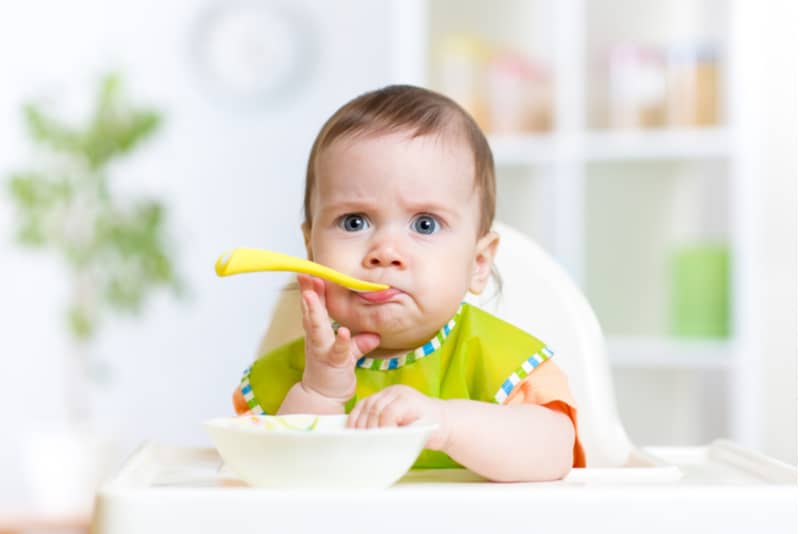Babies are not that complicated… or are they?
What happens when a baby that once had a normal eat-sleep-poop-repeat cycle starts having black specks in baby poop?
What does that say about your baby’s health?
As a new parent, we can often be quite obsessed with looking at our kid’s poop.
Why? Because our baby’s poop can tell us if something is wrong with our kid’s health.
Poop becomes an absolutely normal discussion point at every occasion.
Usually, they’re funny stories about when the baby had a massive blow out or when was the last time she did a number 2.
However, things get interesting and far more severe when we talk about poop color.
There are numerous reasons for a baby’s poop changing color and texture.
For starters, the biggest difference is related to babies who are fed differently.
Breastfed babies and formula-fed babies have different stool types.
Breast milk is easier to digest than baby formula. Few breast-fed babies have problems with digestion, unlike formula-fed babies.
This results in formula-fed babies often getting constipated or getting diarrhea.
As recommended by WHO, babies should start with solid foods at their half birthday
. At six months of age, babies’ digestive systems become mature. However, it’s not necessarily a given that your baby is ready to start eating solids.
If your little one’s not holding her head up steadily, sitting without support, or still has issues with digestion, solids should be postponed for later.
Once your kiddo starts eating solids, the poop’s color and texture will change.
The poop becomes more solid and the color will depend on what the baby had for lunch.
Sometimes, the poop will have food remains in it, such as seeds or fruit skin.
As they grow up, their digestive systems become stronger and they manage to digest most foods much easier.
If they don’t manage to digest something, it will go right through their system directly to their diapers.
Black specks in baby poop are often a result of an inability to digest a certain ingredient such as seeds, or milk, whether it’s mother’s or formula.
These black specks can, in more serious cases, even be a sign of gastrointestinal bleeding.
A runny stool means there’s a trigger that is irritating the baby’s digestive tracts.
You should reduce the amount of solid food intake and consult a pediatrician if the watery stool continues.
Are Black Specks In Baby Poop Harmless?

In most cases, yes, they’re harmless!
Black specks in baby poop are a perfectly normal thing if your baby has a balanced diet.
It’s almost always nothing, and not something you should be concerned about, especially if there are no other symptoms.
Foods such as bananas, berries, beans, kiwi, milk, or even homeopathic meds such as dental medications for teeth growth may cause blacks specks in baby poop.
Monitor your baby closely. If you remember that you gave her a banana for a snack or your baby had berries this morning, then you shouldn’t be worried at all.
However, it is important to note that sometimes these black flecks can mean gastrointestinal bleeding.
Baby poop will change a lot during the baby’s first year.
All stools are fine except a completely black or white one, as well as a bloody stool.
To recap what you’ve learned at mommy class, here’s a word about a full diaper.
How Can I Tell My Baby Has A Normal Poop?

Babies can’t talk so they cry to let us know they want something: food, attention, or a diaper change.
Speaking of diapers…
As I am sure you’re already aware, diapers can tell you a lot about your baby’s health which is why parents usually monitor their babies’ stools closely.
Anything out of the ordinary is usually a warning sign.
So, how to distinguish normal from warning?
I’m sure every “fresh” parent has experienced a new level of stress when it comes to the baby’s digestive tracts. Rarely any baby has one working like a Swiss watch. Problems vary from irregular bowel movements to constipation, colics, colors, or even runny stools.
Even though it may appear ridiculous to monitor a baby’s stool, it’s not. Don’t laugh or roll your eyes when a new mommy is super-excited about her baby’s first stool this week.
You see, any change in a baby’s stool can be worrying. If you’re not familiar with this subject, then you should learn a thing or two about what makes stool good and what not.
Since no baby is the same, every new mom should watch like a hawk for any changes in the stool’s texture, color, or unusual specks. These little surprises in the diaper happen frequently when the baby starts eating solid foods. A baby’s organism is sensitive. It takes time for a little one’s bowels to function properly. These adjustments can even take up to a year.
Depending on your baby’s way of feeding (bottle or boobie), the stool can differ in, pretty much, everything. What I’m about to explain to you should help with further diaper situations.
The Color And Texture Of Normal Baby Poop

After giving birth, you’ll notice the baby’s first poop is always different from normal stools.
It’s called meconium and it starts approximately 2 hours after the birth.
Meconium’s color can be black or have a tint of green and be quite sticky.
Don’t worry, meconium only lasts a short while and after your baby starts nursing, the stool will normalize.
Breastfed baby poop or exclusively breastfed baby’s poo has a light mustard color and contains little grains or has a seedy texture.
The stool’s consistency can vary from runny to very soft.
Formula-fed babies that consume milk or soy-based formula have a tan or yellow stool with a peanut butter consistency.
Babies on hypoallergenic formulas usually have a dark green poop with a pasty or peanut butter consistency.
Stools are sometimes watery too, or formed and hard. The green color is related to the way a baby digests formula.
As mentioned earlier, bloody stools aren’t normal and require a pediatrician’s attention immediately.
Black stools or stools with blood are a clear sign of food allergies.
Also, because babies can’t blow their noses, when they get sick, all that mucus has to go somewhere.
They’ll either throw it up or pass it down through the stool. Some mucus when they’re sick is normal.
However, mucus for a significant period of time can also be a sign of allergies, so make sure to contact your doc.
Baby Poop Colors 101
– Brown is a normal stool.
– Green is a common stool if your baby is on an amino acid-based formula.
– Orange or Yellow stools are a sign the baby is breastfed, or she’s getting introduced to solids and veggies like carrots.
– White stools are a warning sign. The chalky white color can be a symptom of a lack of bile from the liver for proper food digestion.
– Black, tarry poop can be a sign that there’s blood in your baby’s stool which turns black while passing through the digestive system. A bloody stool is often a sign of a milk protein allergy.
– Red stools are fine if your little one had beets for lunch. However, if the baby didn’t eat anything with red pigment, it may be a sign of blood. Bright red blood in the poop means you should rush to the doctor immediately.
Can Baby Poop Look Like Coffee Grounds?
It can, but it shouldn’t.
Baby poop should never resemble coffee grounds.
This is typically caused by old blood in the digestive system which is not harmless at all.
If you notice even just one bit of such stool, you should go visit your pediatrician.
How Often Do Babies Poop?
Every baby is different.
How frequently babies poop can’t be determined by a number or expressed by a rule.
There are newborn babies that have a bowel movement after every feeding while some do the number 2 once a day, and others every other day. It’s never the same.
It takes months for your new baby to form a habit of becoming regular.
It’s recommended that you seek your doctor’s help if the baby doesn’t do the doo doo for more than three days, but for breastfed babies it’s okay not to go for up to two weeks once they turn 3 or 4 months.
The reason for this is that mother’s milk is highly digestible and there’s not much waste.
Breastfed babies poop a lot up to the four week old mark.
After the first month, their bowel movement decreases to 3 to 4 times a day.
Formula-fed babies typically have one or more bowel movements a day.
Babies on hypoallergenic formulas have fewer stools than other babies, especially if they’re consuming a formula without probiotics.
Now that we have discussed how many poops to expect on a daily basis, let’s look at the reasons for black specks in baby poop, which can occur no matter which milk they consume.
What Causes Black Specks In Baby Poop?

We’ve already discussed what a newborn’s stool looks like, and what it turns into after the body cleans itself from the meconium.
So, what happens when your baby starts with solids?
Well, any food that wasn’t properly digested will go through the baby’s poop and cause black spots or specks of a darker color.
You’ll find some of the most common reasons for black specks in baby poop down below.
1. Milk Protein Allergy
Black specks in baby poop can be a sign that your baby has a milk protein allergy.
Animal milk, especially cow’s, has a protein named cazeine, which is highly indigestible by our digestive systems – which applies to all of us, not only babies.
If you suspect your baby’s struggling with a formula based on animal milk proteins, it would be best to ask the pediatrician to switch to a hypoallergenic formula.
This allergy can be permanent, but most babies stop being allergic after their second year as their digestive system starts developing.
2. Can Bananas Cause Black Speck In Poop?
All babies are bananas for bananas!
But, this beloved exotic fruit can cause black specks in baby poop.
These specks will resemble tiny black threads in the poop which are actually from the center of the banana and it’s not something you should be worried about.
However, this doesn’t mean you should give your baby as many bananas as she can eat.
Bananas are quite sugary and can cause constipation.
It’s better to introduce this fruit some time later, not in the first few days of your start with solids.
3. Blueberries And Blackberries
Berries such as blueberries and blackberries are hard to digest, and they leave skin or seeds in the poop.
In addition, the dark colors these berries have will turn the poop into a dark color.
Go back and remember when your baby had blueberries or blackberries.
This morning? Good, then there’s nothing to be worried about!
Those black specks in baby poop are only berries.
As most berries are hard to digest, babies should eat them as a puree.
Also, for safety reasons, you should cut up or mash berries for your baby until she turns one.
4. Black Beans
Even though beans are not a common first food, you can’t deny they make excellent treats.
Cook them until they’re soft, offer them to your baby to pick up and mash between her fingers, and eventually eat it.
If your baby doesn’t digest the beans properly, black specks in baby poop can appear.
Also, if your baby eats lots of iron-rich foods such as black beans, the color of their poop will turn dark and contain specks.
Babies usually start eating beans around 7 to 10 months.
But, they shouldn’t consume too much of them as some beans are harder to digest, while others are not.
If you see black specks in baby poop and you’ve made black beans for lunch today, it’s a no brainer – you shouldn’t worry at all.
5. Colic Calm Gripe Water
Babies that consume Colic Calm Gripe Water for colic, reflux, or gas can have black specks in baby poop too.
Or, the poop color may become darker than usual.
It’s because the vegetable charcoal, one of the main ingredients of the Gripe Water, gets completely expelled through poop and colors it dark or causes specks.
6. Blood
Old blood in your baby’s gastrointestinal tract can cause poop to have black specks.
But, these specks are not like the specks you’ll see after Gripe Water or blueberries.
They resemble coffee grounds and signify there’s a problem inside your little one.
Which Stool Changes Are A Cause For Concern?

Our babies’ diapers will tell us what’s going on with their health status.
While it’s not the most pleasant thing to discuss, with the funny colors and that pungent smell, baby poop is important to all parents.
Any change in it can worry us sick, so it’s better to know how to distinguish between good poop and bad poop.
Some of the most common conditions related to black specks in baby poop are:
1. Diarrhea
Babies tend to have a very runny diarrhea consisting mostly of water.
Their diarrhea can be yellow, green, or brown.
Don’t be surprised if your baby has a massive blowout or explosion in her diaper.
But, how to tell the difference between diarrhea and a runny stool? Diarrhea is defined by a sudden increase in frequency, meaning more than one bowel movement per feeding.
Diarrhea can be caused by many things, i.e. allergies, infections, change in a baby’s diet, especially if you’re breastfeeding.
If you don’t treat diarrhea in time it will lead to dehydration.
2. Constipation
The opposite of diarrhea is constipation.
Hard poop or poop that looks like coffee beans or grounds means your baby is struggling with constipation.
The obvious signs are an uncomfortable face when pooping and blood traces in the stool as it’s pushed out with a big effort.
The first days of introducing solids may be marked with your baby becoming constipated.
It also happens when a baby is intolerant of an ingredient found in breastmilk or formula, i.e. soy proteins or milk proteins.
Weaning and switching to formula can also cause constipation.
3. Dehydration
A baby that has hard or dry stools, no matter if she’s a breastfed baby or formula fed, lacks fluids and is not hydrated enough.
Also, dehydration occurs if a baby is sick with fever or heat and loses too much fluids.
You need to introduce ORS supplements to restore hydration and prevent further damage to your little one and her tiny body.
4. Stringy poop
Green poop with shiny or sparkling strings means there’s mucus in it.
Sometimes this occurs because the baby is teething and drooling too much, so she can’t digest all the produced saliva.
However, too much mucus for a longer period of time means there’s an infection or allergy that has to be treated.
5. Bloody poop
Bright red blood can happen for several reasons:
– Normal poop tinted with red blood is a sign of a milk protein allergy.
– Blood in hard stool is a result of force and tears in the anus or even tiny hemorrhoids.
– Diarrhea mixed with red blood means there’s a bacterial infection.
When Should I Ask For Pediatric Medical Advice?

Use our favorite unwritten rule: better safe than sorry!
It’s always better to visit your pediatrician for nothing, than to stay at home and do nothing.
Odd-colored poop or issues with the texture, even foamy stools, could be a sign something’s wrong and you should react.
When you notice significant changes in your baby’s poop, such as pooping less or more often than usual, you should contact your pediatrician.
Here’s when you should give him a ring:
– When the baby seems uncomfortable pooping, starts making faces, shows she’s using much force, etc.
– When a 3-month-old has diarrhea twice or more or keeps on having the runs for longer than a day or two.
– When there’s blood in your baby’s stool.
– When there’s mucus in your baby’s diaper for more than a day or so.
– When your baby’s poop is black, but the baby isn’t taking iron supplements.
– When you see flecks of digested blood that look like poppy or sesame seeds, especially if you’re breastfeeding and having difficulties.
– When the baby has pebbly texture in the diaper more than three times.
– When the baby eats solids and keeps on having undigested food in poop. Such cases often show the baby is having problems with her intestines absorbing nutrients.
The following types of poop are rare, but signify severe problems and require your pediatrician’s medical attention immediately:
– Thick black poop, dark and tarry like meconium, but less sticky and more firm. This poop is usually made of digested blood.
– Completely red blood poop also known as currant jelly. This is an indicator of severe intestinal issues.
– White, pale, chalky, or clay-colored poop means the liver or gallbladder has failed.
To Sum Up
Black specks in baby poop are completely normal if there’s nothing else wrong with your kid.
That’s why you should monitor your baby closely, watch what she eats, and look for any signs that there’s something out of the ordinary with her diet and digestion.
Many foods such as blueberries, bananas, blackberries, beans, grapes, or kiwi can cause black speck in baby poop.
Black specks in baby poop can mean traces of undigested food listed above, but it can also signify that there’s blood in the stool or even more severe infections.
While all stool colors, except for black and white, are normal, any stool speckled with red dots are not to be left untreated.
Your pediatrician should be informed about it to find a reason for these black specks.
Whether it’s our fast-paced lifestyle or the many changes that we’ve introduced into the world’s diet, many babies nowadays are getting diagnosed with milk protein allergy.
This allergy causes intestinal bleeding and should be treated immediately by switching the formula or excluding everything with milk proteins from the mother’s diet.
If your baby has a sensitive stomach, there’s a list of foods you can’t eat while breastfeeding.
No matter if it’s a breastfed or a bottle-fed baby, they all can experience black specks in baby poop.
The important thing is not to panic, trace back your steps, and ask for the pediatrician’s help before things get too serious.
You’ve got this mamma!
Like this post? Please share or pin it for later. You can also stay in the loop and follow us on Facebook, Instagram or Pinterest.

We love honesty! Find Your Mom Tribe is an Amazon Associate and we earn from qualifying purchases through affiliate links at no extra cost to you. Please see our full Amazon Affiliate disclosure for more information.

